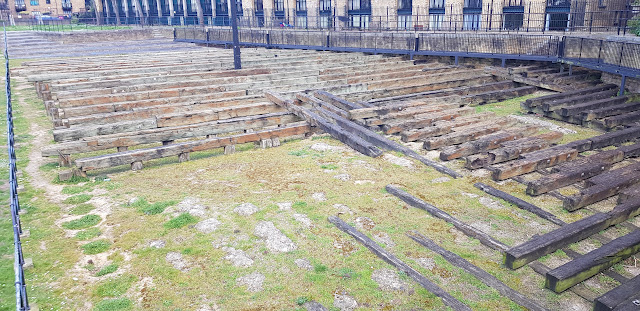 |
| Canary Wharf across the fields. |
One of the places that I have begun to visit more and more, lately, is the Isle of Dogs. Not just the Canary Wharf area, the Museum of London Docklands or Crossrail Place Roof Garden (which is beautiful in the summer months), but the rest of this piece of land that has the River Thames meandering around it.
 |
| The North Dock. |
From the historic launch ramps of the SS Great Eastern to the oldest public house on the Island. From Cubitt Town to Millwall. From Mudchute Park and Farm to Island Gardens, there is much to discover.
 |
| Crossrail Place Roof Garden. |
To walk around the Isle takes less than two hours and it is a revealing experience.
 |
| One Bank Street. |
Unlike many other areas in this neck of the woods, the history of this piece of London and its people has been kept. This may have something to do with the east end ethic of history and community, rather than a conscious effort on the part of local government.
 |
| The oldest pub on the Island. |
Regardless, there is always something to discover and wonder at as you wander around what was, up until fairly recent times, a patch of marshland that was prone to flooding.
Brief History
Before the West India Docks were opened in 1802, the Isle of Dogs was a marshy grassland, crisscrossed by drainage ditches, and was prone to flooding at high tide. This was due to the land being below high tide, and so banks were built on the eastern side. If these weren't maintained then the entire area would flood, which happened in 1448 leaving the land underwater for four decades.
In 1660 the River Thames began to force its way through the northern end of the Island, roughly where the west entrance to the South Dock is now situated. The inhabitants intervend and the area became known as The Breach. However, enough water had made it onto the Island that a 5-acre lake, named Poplar Gut, was formed.
Cattle were grazed on the nutritious marshland and slaughtered in an area that would become known as The Killing Fields, which were just south of Poplar High Street.
With the construction of the West India Docks, beginning in 1802, industries began to flourish on the island. Flour and sugar processing and shipbuilding being among the most lucrative.
As the industries boomed so did its inhabitants, which had a working population of 5,000 by the 1850s.
The latter half of the 19th century saw further growth with the building of Cubitt Town in the east, the opening of the Millwall Docks and the Millwall Extension Railway, which all brought manufacturing firms to the river's edge.
The SS Great Eastern, which was the largest ship built at the time, was built and launched from Millwall in 1858, while the first British warship designed with her main armament in gun turrets, HMS Prince Albert, was launched from Cubitt Town, in 1864.
 |
| The launch ramp for the SS Great Eastern. |
In 1902 the opening of the Greenwich Foot Tunnel allowed for more people to come to the island, but this did sound the death knell for the Ferry which many had used up until this point.
With a population of over 21,000, at the end of the century, a close-knit community had formed, as it was somewhat cut off from the rest of the East London. The customs, traditions and way of life continued undisrupted until the outbreak of World War II.
During the Blitz many homes and factories were destroyed and the population dropped to less than 10, 000. Ack-Ack guns were installed throughout the island, throughout this period, in an attempt to stop the Luftwaffe. The docks were also severely damaged during the bombing and to this day unexploded bombs are still being unearthed.
 |
| In defence of the Island. |
Post-war kicked off with housing construction and an export driver in order to boost economic growth, which lasted throughout the 1950-60s, but an economic decline began in the 1970s.
In 1977 the Mudchute Park and Farm opened on 32 acres of land.
By 1980 the last of the docks closed, due in part to the containerisation of shipping, which the docks were ill-equipped to support. This left much of the area in a derelict and dilapidated state.
In 1982 Billingsgate Fish Market moved to a new building at the eastern end of the North Dock.
In 1981 redevelopment began with the London Docklands Development Corporation being formed and things soon progressed. An Enterprise Zone was created and construction proper began in 1988.
The London Docklands Development Corporation helped to create Canary Wharf, Surrey Quays shopping centre, London City Airport, ExCeL Exhibition Centre, London Arena and the Docklands Light Railway.
In its seventeen years of existence the London Docklands Development Corporation created more than 120,000 new jobs and made the area a prime location for housing.
The IRA detonated a truck bomb near South Quay DLR station, on 9 February 1996, that killed two people and injured more than a hundred others.
Trivia
- There are currently 2 Grade I listed buildings in Canary Wharf
- There are currently 14 Grade II listed buildings in Canary Wharf
- The Landmark Pinnacle is the tallest residential building in Europe
Another full and interesting history and great pics. When's your book coming out?
ReplyDeleteThank you. I am still working on the second book, while reworking the first.
Delete